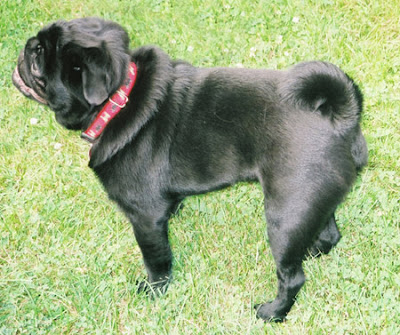Physical characteristics
While the pugs that are depicted in eighteenth century prints tend to be long and lean,modern breed preferences are for a square cobby body, a compact form, a deep chest, and well-developed muscle. Their smooth and glossy coats can be fawn, apricot fawn, silver fawn, or black. The markings are clearly defined and there is a trace of a black line extending from the occiput to the tail. The tail normally curls tightly over the hip.
Pugs have two distinct shapes for their ears, "rose" and "button". "Rose" ears are smaller than the standard style of "button" ears, and are folded with the front edge against the side of the head. Breeding preference goes to "button" style ears.
Pugs' legs are very strong, straight, of moderate length, and are set well under. Their shoulders are moderately laid back. Their ankles are strong, their feet are small, their toes are well split-up, and their nails are black. The lower teeth normally protrude further than their upper, resulting in an under-bite.
The breed is often described as multum in parvo, or "much in little", alluding to the pug's remarkable personality, despite its small size. Pugs are strong willed but rarely aggressive, and are suitable for families with children. The majority of the breed is very fond of children and sturdy enough to properly play with them. Depending on their owner's mood, they can be quiet and docile but also vivacious and teasing.
Health problems
Since pugs lack longer snouts and prominent skeletal brow ridges, they are susceptible to eye injuries such as proptosis, scratched corneas, and painful entropion. They also have compact breathing passageways, leaving many prone to breathing difficulties or unable to efficiently regulate their temperature through evaporation from the tongue by panting. A pug's normal body temperature is between 101 °F (38 °C) and 102 °F (39 °C). If this temperature rises to 105 °F (41 °C), oxygen demand is greatly increased and immediate cooling is required. If body temperature reaches 108 °F (42 °C), organ failure can occur.
Pugs that live a mostly sedentary life can be prone to obesity, though this is avoidable with regular exercise and a healthy diet. The median life span of pugs is 11 years, which is in line with other breeds of the same size.
Data refer : http://en.wikipedia.org/wiki/Pug_dog






